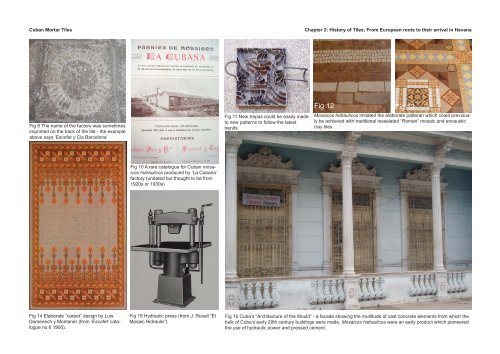Cuban Mortar Tiles - infogram.co.uk > Home
Cuban Mortar Tiles - infogram.co.uk > Home
Cuban Mortar Tiles - infogram.co.uk > Home
You also want an ePaper? Increase the reach of your titles
YUMPU automatically turns print PDFs into web optimized ePapers that Google loves.
<strong>Cuban</strong> <strong>Mortar</strong> <strong>Tiles</strong> Chapter 2: History of <strong>Tiles</strong>; From European roots to their arrival in Havana<br />
Fig 9 The name of the factory was sometimes<br />
imprinted on the back of the tile - the example<br />
above says ‘Es<strong>co</strong>fet y Cia Barcelona’<br />
Fig 14 Elaborate “carpet” design by Luis<br />
Domenech y Montaner (from ‘Es<strong>co</strong>fet’ catalogue<br />
no 6 1900).<br />
Fig 10 A rare catalogue for <strong>Cuban</strong> mosai<strong>co</strong>s<br />
hidrauli<strong>co</strong>s produced by ‘La <strong>Cuban</strong>a’<br />
factory (undated but thought to be from<br />
1920s or 1930s)<br />
Fig 15 Hydraulic press (from J. Rosell “El<br />
Mosaic Hidraulic”)<br />
Fig 11 New trepas <strong>co</strong>uld be easily made<br />
to new patterns to follow the latest<br />
trends.<br />
Fig 12 Fig 13<br />
Mosai<strong>co</strong>s hidrauli<strong>co</strong>s imitated the elaborate patteran which <strong>co</strong>uld previously<br />
be achieved with traditional tesselated “Roman” mosaic and encaustic<br />
clay tiles<br />
Fig 16 Cuba’s “Architecture of the Mould” - a facade showing the multitude of cast <strong>co</strong>ncrete elements from which the<br />
bulk of Cuba’s early 20th century buildings were made. Mosai<strong>co</strong>s hidrauli<strong>co</strong>s were an early product which pioneered<br />
the use of hydraulic power and pressed cement.



